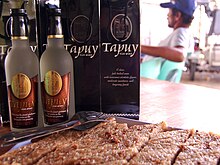Philippine wine

Philippine wine or Filipino wine are various wines produced in the Philippines. They include indigenous wines fermented from palm sap, rice, job's tears, sugarcane, and honey; as well as modern wines mostly produced from various fruit crops.
Pre-colonial

Indigenous wine-making traditions in the Philippines dates back to before the
Palm wines
Among the most widely prevalent wines produced in the Philippines is the
A notable variant of tubâ from the
During the
Rice wines

Rice wines used to be common in pre-colonial times, as part of the process of
Among the
Sugarcane wines
Sugarcane wines include the
Another sugarcane wine was the
Mead
Modern wines
Most of the modern wines produced in the country are based on locally produced crops with
Modern local wines are mostly
References
- ^ a b c d Gibbs, H.D.; Holmes, W.C. (1912). "The Alcohol Industry of the Philippine Islands Part II: Distilled Liquors; their Consumption and Manufacture". The Philippine Journal of Science: Section A. 7: 19–46.
- ^ Lasco, Gideon. "Tagay: Why there's no Tagalog word for "cheers" and other notes on Filipino drinking culture". Health, Culture, and Society in the Philippines. Retrieved 6 May 2019.
- ^ Garcia, Lawrence. "Tagay: A Look at Philippine Drinking Culture". Humaling. Retrieved 6 May 2019.
- ^ a b Polistico, Edgie. "Tungog". Philippine Food Illustrated. Retrieved 21 April 2019.
- ^ "How Tuba and Bahalina, Also Known as Coconut Wine, Are Made". Delishably. Retrieved 21 April 2019.
- ^ "Do You Know What Kinutil Is?". Bite Sized. Retrieved 5 May 2019.
- ^ Damo, Ida. "Kinutil: The Filipino Mudslide Drink". ChoosePhilippines. Retrieved 5 May 2019.
- ^ "Comfort food ng mga Waray". Kapuso Mo, Jessica Soho. GMA Public Affairs. Retrieved 5 May 2019.
- ^ a b Demetrio, Feorillo Petronilo A. III (2012). "Colonization and Alcoholic Beverages of Early Visayans from Samar and Leyte". Malay. 25 (1): 1–18.
- ^ Gico, Emma T.; Ybarzabal, Evelyn R. "Indigenous Rice Wine Making in Central Panay, Philippines". Central Philippine University. Retrieved 4 May 2019.
- JSTOR 42720408.
- ^ Caldo, Gloria A.; Hiroshige, Sakai (1985). "Microbiological studies on pangasi, a rice wine in Mindanao". The Philippine Agriculturist. 68 (4).
- ^ Rice Wine Technology Bulletin, Philippine Rice Research Institute (2000)
- ISBN 9789712339349. Retrieved 1 January 2017.
- ^ Feraren, John Mychal. "Ten Proofs We Inherited Our Love for Drinking from Pre-Colonial Filipinos". Claire Delfin Media. Archived from the original on 9 May 2019. Retrieved 5 May 2019.
- ^ ISBN 9781462916894.
- ^ a b Garvan, John M. (1912). "Report on the drinks and drinking among the Mandaya, Manobo, and Mangguangan Tribes". The Philippine Journal of Science: Section A. 7: 106–114.
- ^ "The Philippine Wine Industry". Wanzui. Beijing Realce Investment Industry Co., Ltd. Retrieved 1 January 2017.
- ^ Beltran, Cito (3 February 2012). "Do they make wine in the Philippines?". CTALK. The Philippine Star. Retrieved 1 January 2017.
- ^ Miranda, Roselle. "Duhat And Bignay Are The Fruits You Should Be Drinking". Yummy.ph. Retrieved 5 May 2019.
- ^ Piccio, Belle. "Proudly Filipino: Wonder Wine from the Country's Sugar Capital". ChoosePhilippines. Retrieved 5 May 2019.
- ^ "How to Make Bignay Wine". Business Diary Philippines. Retrieved 5 May 2019.
- ^ Lagsa, Bobby. "The women wine makers of Bolisong". Rappler. Retrieved 5 May 2019.
- ^ "How to Make Duhat Wine". Business Diary Philippines. Retrieved 5 May 2019.
- ^ Miranda, Roselle. "Duhat And Bignay Are The Fruits You Should Be Drinking". Yummy.ph. Retrieved 5 May 2019.
- ^ dela Cruz, Aissa (26 November 2011). "A toast to Conrad's Mango Wine". Philippine Daily Inquirer. Retrieved 18 November 2019.
- ^ "How to Make Mango Wine". Business Diary Philippines. 5 September 2019. Retrieved 18 November 2019.
- ^ Ramoran, Carol (25 February 2014). "Mango rum, barako liqueur, and more local drinks to try". Rappler. Retrieved 1 January 2017.
- ^ Valmero, Anna (17 September 2012). "Quezon's oregano wine makes it to wine festival in Italy". Science.ph. Retrieved 18 November 2019.

